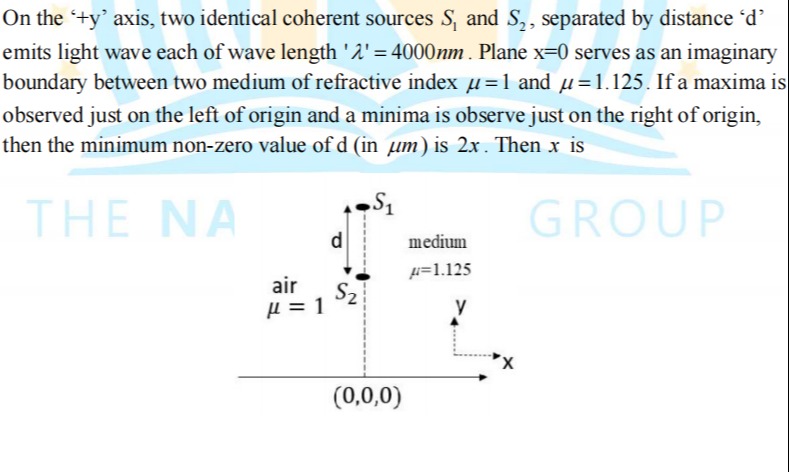Question
Question: On the '+y' axis, two identical coherent sources $S_1$ and $S_2$, separated by distance 'd' emits li...
On the '+y' axis, two identical coherent sources S1 and S2, separated by distance 'd' emits light wave each of wave length 'λ' = 4000nm. Plane x=0 serves as an imaginary boundary between two medium of refractive index μ = 1 and μ = 1.125. If a maxima is observed just on the left of origin and a minima is observe just on the right of origin, then the minimum non-zero value of d (in μm) is 2x. Then x is

32
64
128
256
64
Solution
The path difference for constructive interference in the first medium (μ1=1) is d=nλ, where n is an integer. The path difference for destructive interference in the second medium (μ2=1.125) is μ2d=(m+1/2)λ′, where λ′ is the wavelength in the second medium. The wavelength in the second medium is λ′=λ/μ2. Thus, μ2d=(m+1/2)(λ/μ2). Substituting d=nλ into the second equation gives μ2(nλ)=(m+1/2)(λ/μ2). This simplifies to μ22n=m+1/2. Substituting the values, (1.125)2n=m+0.5, which is (9/8)2n=m+1/2, or 81/64n=m+1/2. Multiplying by 64, we get 81n=64m+32, or 81n−64m=32. This is a linear Diophantine equation. Using the Extended Euclidean Algorithm, we find that 81(480)−64(608)=32. The general solution is n=480−64k and m=608−81k. We need the minimum positive integer value for n. For n>0, 480−64k>0, so k<480/64=7.5. The largest integer value for k is 7. When k=7, n=480−64(7)=480−448=32. This is the minimum positive integer value for n. The minimum non-zero value of d is d=nλ=32×4000 nm =128000 nm. Converting to μm, d=128μm. The problem states d=2x, so 2x=128μm, which means x=64.
